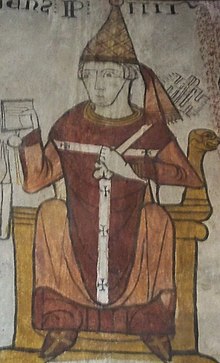Clement IV | |
|---|---|
| Bishop of Rome | |
 Clement IV depicted in a 13th century fresco | |
| Church | Catholic Church |
| Papacy began | 5 February 1265 |
| Papacy ended | 23 November 1268 |
| Predecessor | Urban IV |
| Successor | Gregory X |
| Previous post(s) |
|
| Orders | |
| Consecration | 1257 |
| Created cardinal | 17 December 1261 by Urban IV |
| Personal details | |
| Born | Gui Foucois c. 23 November 1190 |
| Died | 29 November 1268 (aged 78) Viterbo, Papal States |
| Coat of arms |  |
| Other popes named Clement | |
Ordination history of Pope Clement IV | |||||||||||||||||||||||||||
|---|---|---|---|---|---|---|---|---|---|---|---|---|---|---|---|---|---|---|---|---|---|---|---|---|---|---|---|
| |||||||||||||||||||||||||||
| |||||||||||||||||||||||||||
Pope Clement IV (Latin: Clemens IV; c. 23 November 1190 – 29 November 1268), born Gui Foucois (Latin: Guido Falcodius; French: Guy de Foulques or Guy Foulques)[1] and also known as Guy le Gros (French for "Guy the Fat"; Italian: Guido il Grosso), was bishop of Le Puy (1257–1260), archbishop of Narbonne (1259–1261), cardinal of Sabina (1261–1265), and head of the Catholic Church from 5 February 1265 until his death. His election as pope occurred at a conclave held at Perugia that lasted four months while cardinals argued over whether to call in Charles I of Anjou, the youngest brother of Louis IX of France, to carry on the papal war against the Hohenstaufens. Pope Clement was a patron of Thomas Aquinas and of Roger Bacon, encouraging Bacon in the writing of his Opus Majus, which included important treatises on optics and the scientific method.